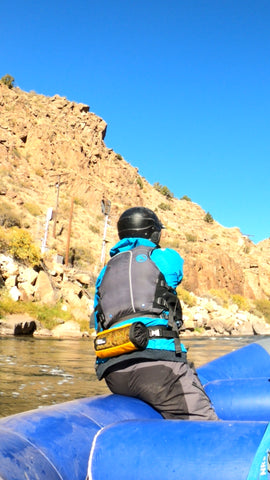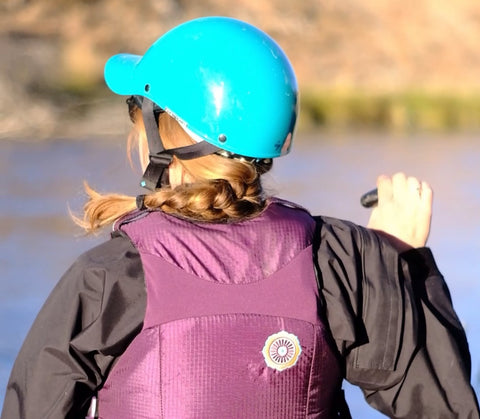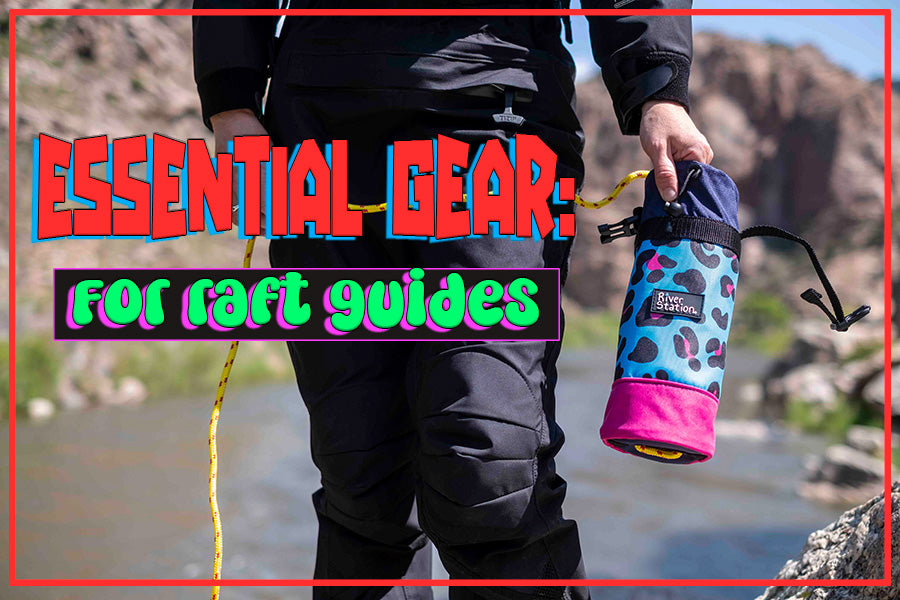You can take all sorts of fun stuff down the river. Cornhole, Bocce Ball, squirt guns, costumes, sauna tents, but today we are going to talk basics. The absolute essential gear you need to be a raft guide. We are going to assume that you work for a company that provides whitewater rafts and paddles. If not, better save up for a boat of your own, or maybe switch to a more reputable company!

PFD (Life Jacket)
This may sound really obvious, but there is a staggering amount of people who enter the river every year without such a device. A personal floatation device is what keeps your head above water, I mean this isn’t rocket science. I don’t think people realize what lies beneath the surface of the river, or how strong eddies can be even in flat water. As a raft guide, you will definitely be required to wear a life jacket anytime you are on the river.
There are quite a few options to choose from when it comes to picking a PFD. 5 types of life jackets exist, but today we are mostly going to talk about Type 3 and Type 5 life jackets. Customers might be wearing Type 2 PFD’s which have super high buoyancy and will turn an unconscious body face up automatically. Type 3 or 5 is what you will likely use as a raft guide. Type 3 would be fine for most common raft guides. They are comfortable, keep you afloat, and also allow your body to move well. If you are swimming in the river, having good mobility is key. Type 5 PFD’s are similar but usually have extra features for rescue. Like a quick release tow strap or live bait rescue strap. These jackets are typically used by more experienced guides who have higher levels of training than the average raft guide. Make sure you take a swiftwater rescue course if you are passionate about learning advanced whitewater rescue techniques.
Other features to look for are places to attach a knife and a whistle, which will likely be required to carry on you. Most PFD’s will have at least one pocket for carrying things like flip lines, snacks, sunscreen, or medications. If you want to get really fancy, look for a PFD with fleece hand warmers for those colder paddling days. Lastly you want to get something that looks good and makes you look unique on the river. There are so many different fun colors and designs to choose from these days. If you don’t know where to start, check out Astral Designs PFD’s.
Helmet
I once asked my boss if I could just wear my hat on the beginner section. His response: “Studies show the rocks up there are just as hard as the rocks down here.” And he has a good point. You never really know when you are going to need your helmet. It is only going to be useful if it's on your head at all times when you are on the river. Like PFD’s there are many different options when it comes to helmets. But generally they are all going to protect your head from impact that could knock you unconscious. I shouldn’t need to state that being unconscious and being in the water are not a good mix.
Kayaking Helmets -
Kayaking helmets usually have ear protection built in or can even be full face. You need a little more protection when kayaking to keep your face nice and beautiful. We all love to look good out there, so keep yourself protected!
Rafting Helmets -
Typically rafting helmets do not cover the ears. You are less likely to be submerged in water and are likely to be in the sun a lot. Keeping your ears free keeps air flow moving around your head. Which is great on a hot day, but I still wear a kayaking helmet when I’m rafting in colder weather.
No Helmet -
There definitely is a time and place to go without a helmet. If you are on a familiar class 2 section of water, at mild flows, it wouldn’t be the worst thing to go without a helmet. Sometimes if you are floating in a flat section on a hot day, it would actually be more beneficial to wear a sun protection hat. But having a helmet handy and ready is always a good call for when the river livens up. Check out Sweet Protection helmets if you need a place to start.

Dry Bag
As a guide, keeping certain things dry is an absolute necessity. You will likely have a radio, customer splash jackets, and probably a phone. Food is always good to carry and there is nothing worse than getting to a lunch area and your sandwich is soaked. There are quite a few different types of dry bags out there. We will go over a very basic option and then go into more detail on our very own River Station Gear - Dry Thwart Bag.
Basic dry bags come in all shapes and sizes. A few smaller dry bags can be useful for keeping things separate. Like one for a first aid kit, and another with a boat repair kit, both of which could be kept in a larger dry bag. A medium dry bag is what you will likely use for commercial day tripping. They are not too bulky but good enough to carry down the necessities. You will need a large dry bag if you work for a company who likes to have a dry sweep kit, or a company that does lots of overnight or multi day trips. On a multi day you will be carrying sleeping equipment, changes of clothing, food, and toiletries, and a good large dry bag will be essential.
Now onto the RSG Dry Thwart Bag. We made this to be functional in every way stated above but it has backpack straps that go around your thwart. This most importantly allows you to access your gear faster because you will not have to de-rigg or unstrap the bag from an external strap. You can just get in and out of it with ease. We do alot of filming and camera work on the river and we are constantly getting out and putting away different cameras and lenses. It is SO nice to be able to quickly do this on the move without have to pull over. Other really nice benefits are that it has built in OS handles and D-Rings. So now you have even more places to clip helmets, water bottles or any extra gear. Lastly, it also doubles as a backpack or an easy way to carry your gear to and from the boat/shuttle. We’ve been using this while commercial guide and it is so much better than a normal dry bag. Highly recommended! You can find a link the back right here!

Throw Bag
There are so many useful ways to use a throw bag on a river trip. At the very least, you need to bring rope. Like all gear, there are quite a lot of different options for throw bags. Boat bags, compact throw bags, waist throw bags, and kayak bags.
Boat Bags -
Typically these are going to be larger throw bags, with strong, thick rope. 65’ to 75’ would be typical for one of these throw bags and they can be used for z-drags and unsticking boats. They can also be used for bagging swimmers. If you are on a smaller section of river, this length may be unnecessary for swimmers. These will typically be clipped into your boat in a quickly accessible spot.
Compact Throw Bags -
Like a boat bag, but more compact. These generally have 60’ of a smaller diameter rope. Their more compact size makes them much easier to throw accurately and far. They take up less room and if you upgrade them to have thin Dyneema rope, you now have a compact bag strong enough to unstick a boat or do a z-drag. This would replace the need to carry a large boat bag.
Waist Throw Bag -
This is a great option for more experienced guides. Once you have proper training with a rope and a good knowledge of the river, these are very good to have. The main benefit is that your rope is always with you. If you take a swim, flip, or have to go running down shore, you will have your rope with you. We’ve seen many guides go running down shore to help a situation only to realize they forgot their throw bag back in the boat. A waist throw bag solves that problem!
Kayaking Bags -
These are just really compact throw bags. Usually 7mm rope with around 45’-55’ of reach. Easy to stow away in a kayak or great for pack rafting. Make sure you do your research and pick a throw bag that suits you and your needs best.

Clothing
There is a time and a place for everything. Rowing down your favorite rapid, on a remote section of river in your birthday suit can be fun. But generally speaking, you are going to want to at least keep your body protected from the harsh summer sun. Depending on the time of the season, there are lots of options for clothing.
Spring -
Spring boating can be cold air temps and cold water temps. I highly recommend a dry suit for this season if you can afford one. It is a luxury that is great, but you can survive without one if you’d rather not break the bank. Wearing fleece, non cotton layers underneath splash gear is a good place to start. While this won’t keep you dry if you swim, it will keep you mostly dry if you keep your boat right side up!
Summer -
Early summer can be snowmelt runoff, and you might want to refer to the paragraph above. But once the run off is over and it's nice and hot, you will want to switch gears. It may be tempting to strip down to almost nothing, which is fine some of the time. But if you are guiding 7 days a week you will need to protect yourself from the sun. Wearing ultra light, hooded, long sleeve shirts is a great way to keep cool and protected. If it’s really hot you can even wear a cotton shirt, this will keep you cool because the cotton will stay wet and not keep your body heat in.
Fall -
This can be similar to Spring. Although fall the air temperature can still be quite warm even after the water temperatures plummet. At this point in the season the water will likely be low and not so splashy. I find myself wearing a light sweater over a light base layer. As long as you stay in the boat, this will likely be fine. If you are running a difficult section of whitewater then maybe dry suit up, especially if the water temps have dropped. Shocking your body with a cold water swim in the river isn’t always the best thing
Winter -
This is the time to break the bank and get a dry suit. Not much else to be said here. If you are confident enough to be boating in wintery/snowy conditions, you are likely experienced enough to know this. Cold water is dangerous. Suit up!
Gear Bag
I’ve said this before in many blog posts, this is a piece of gear that I really didn’t know I needed until I made myself one. All of the pieces of gear mentioned above used to be strewn about my gear room, car, or boat house. A gear bag is a place to keep all of that gear, so that when it comes time to go boating, you only need to find one bag. We don’t really use these for rafting, just transporting gear. Most gear bags you find are going to be made of mesh. This is important because it's breathable and allows your damp gear to dry out. If you are on the river as a raft guide 7 days a week, it is essential to keep things as dry as possible. Dry gear will help with that ever so distinct raft guide smell also! You can find a link to our sweet Eterna Mesh Gear Bag right here!

Now you are all ready to gear up and get on the river! Let us know if we missed anything in the comments below!
By: Jason Caligaris Jr.





Share:
Beginners Guide to the Multi-Day Trip
Why River Station Gear?